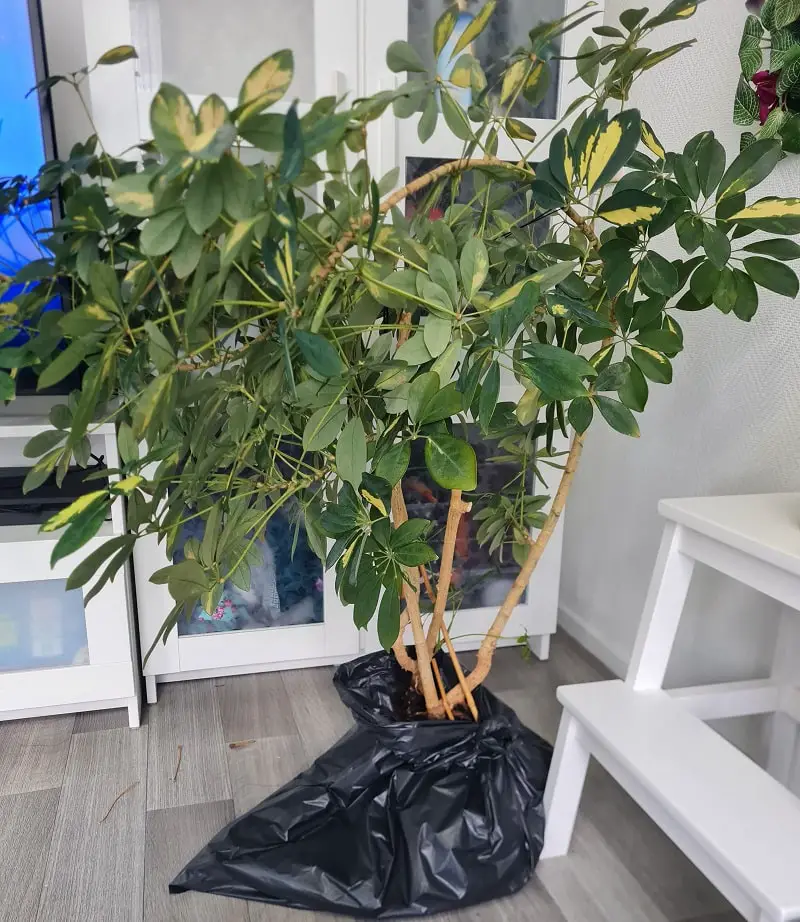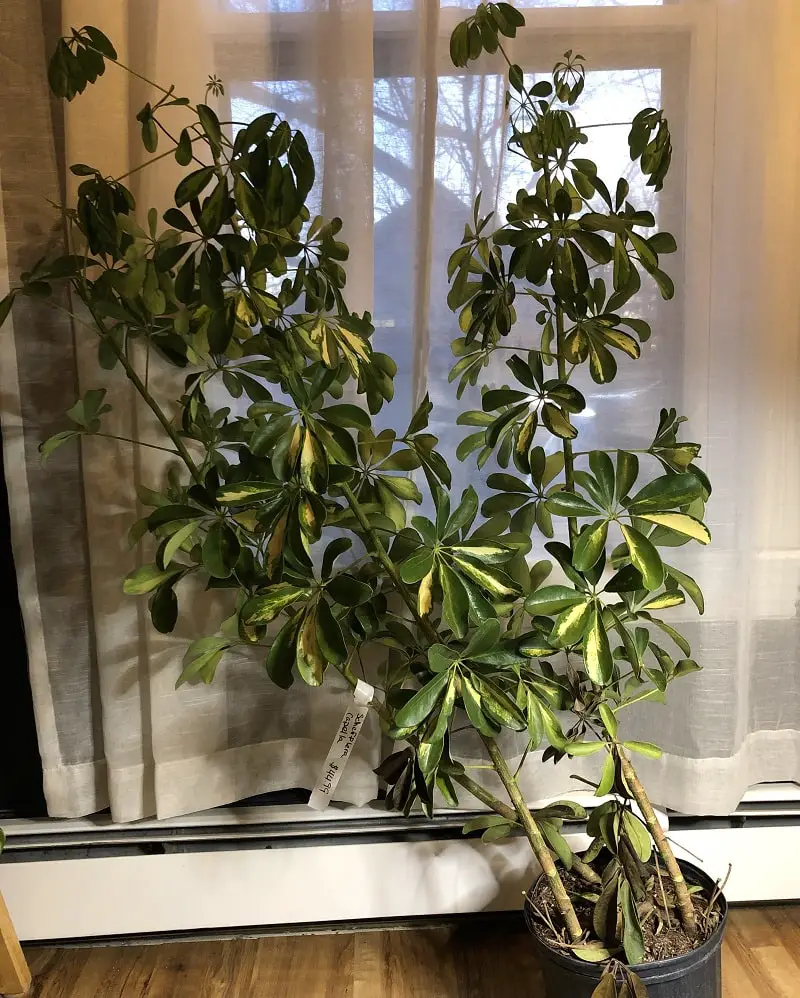The Umbrella plant (Schefflera) is the easiest houseplant to grow and maintain. The umbrella-like leaves add a tropical feeling to the room. But this houseplant needs an ultimate care regime to avoid leaves drooping, curling, turning yellow and brown.
So, why is my umbrella plant drooping? Possible causes are overwatering, cold stress, transplant shock, under-watering, and over-fertilization. Identifying the cause of Schefflera drooping will help in fixing the problem.
Keep reading this article to learn how to save a drooping umbrella plant. Fixing Schefflera falling over is a no-brainer after identifying the cause. But if the condition persists for a couple of weeks, the umbrella plant will die.
You May Also Like: Why Is My Peace Lily Leaves Turning Yellow

8 Reasons Why Your Umbrella Plant Is Drooping
You’ll learn how to identify the causes of umbrella plant drooping and quick tips for fixing the problem regardless of your experience. Let’s get started:
Overwatered Schefflera
Overwatering is the leading cause of umbrella plant drooping. The issue occurs due to improper drainage potting soil that results in a damp environment.
Schefflera plants do not thrive in wet conditions. The roots will suffer from root rot disease and eventually die. Root rot inhibits the plant from absorbing nutrients and water for survival.
Umbrella plant wilting, leaves turning yellow, and smelling potting soil are crucial symptoms of overwatering problems. Umbrella plant droops due to dehydration in the long run.
The best solution is to re-pot the houseplant to save it from dying. Use fresh potting soil with proper drainage. Snip the affected roots with a sterilized pair of scissors.
The new container should have drainage holes at the bottom to help drain excess water around the plant roots. Provide an ultimate umbrella plant care to experience the tropical vibes.
Cold Draft Stress
Umbrella plants thrive under a temperature range of 65-90oF (18-30oC) in their native habitat. But this houseplant can also tolerate a temperature below 35oF for a shorter period.
Exposing an umbrella plant to freezing temperatures for an extended period is likely to droop and eventually die. The issue is prevalent when the plant is near a window vent or air conditioner.
The cold stress makes the roots hardy and unable to undertake their physiological processes. The plant will recover when provided with optimum temperature requirements.
Umbrella Plant Transplant Shock
Schefflera plant is more vulnerable to the root-bound issue. Every houseplant enthusiast needs to re-pot the plant after 2-3 years. It will help to prevent root-bound related problems.
But re-potting would cause stress or shock to the umbrella plant. The transplant stress makes the roots cease functioning for a shorter period. The plant will later start drooping in response to the issue.
Schefflera plants are more resilient than other houseplants. Proper care will enable the houseplant nurse the transplant shock and recover.
You’ll need to consider a gentle transplant to avoid stressing the houseplant. Do not disturb the roots in the process and provide a condition for better results.
You May Also Enjoy: Why Is My Zebra Plant Leaves Drooping?
Inconsistent Watering Habits
Under-watering is another cause of umbrella plant drooping. Many plant owners’ finding it challenging to water their umbrella plant due to busy schedules.
Drooping and wilting are the main signs of umbrella plant dehydration. Other symptoms are Schefflera leaves curling and turning brown on the tips.
Consider inspecting the soil moisture content before watering-If the topsoil is dry, water the plant to facilitate hydration and solve the issue.
Come up with a watering schedule depending on the season to avoid overwatering and under-watering problems. Watering should be twice a week in summer and once a month in winter.
Insufficient Light Levels
Umbrella plants prefer bright indirect sunlight. Ensure the indoor growing condition mimics their natural habitat to enjoy the tropical feeling.
When the houseplant is grown in a dark room, the stems and branches will become leggy. The leaves also will start to droop and fall one by one.
Relocate the current position of the umbrella plant to a region that receives bright indirect sunlight. Do not move your Schefflera plant closer to the window during the winter season.
Another alternative is to install Grow LED Lights (Check Best Deals on Amazon) in the room, not receiving natural light. The artificial light will enable the plant to thrive.
Lack of Humidity
Schefflera plant is a type of tropical plant. These plants prefer a warm and humid environment to thrive. Dry air around the plant makes the leaves droop and become crispy in the long run.
The best solution is to increase humidity around the plant to prevent drooping. Misting the plant leaves or installing an automatic humidifier will save the plant from drooping.
Remember to keep the umbrella plant away from vents and heaters since they have the reputation of drying air around the plant.
Pest Infestations
The umbrella plants are more vulnerable to a range of pests. Spider mites, aphids, scales, and mealybugs are the most common pests that attack Schefflera plants.
These bugs suck cell-sap from the plant. The frequent piercing dehydrates and stresses the houseplant and displays displeasure by drooping in the long run.
Inspect your plant to spot any signs of insect infestations. Remember to isolate the plant from other houseplants to prevent the spreading of bugs.
Use either neem oil or horticulture soap to spray the plant. These compounds will help to eliminate the bugs from your plant.
Over-Fertilization
Schefflera plants are not heavy feeders like other outdoor trees. But these plants need fertilizer for their nourishment and better growth.
But too much fertilizer might be harmful to the plant. The salt buildup around the roots inhibits water absorption from the soil to the rest of the plant.
The umbrella plant will showcase the stress by drooping and leaves turning brown along the edges and tips. If the condition persists, the plant is likely to die.
I recommend re-potting the plant to fresh potting soil rather than flushing the existing one. Use a potting mix with balanced nutrients and provide better umbrella plant care.
Flushing the soil increases the risk of overwatering and other leaf-related problems. The wet condition causes root rot to the plant.
You May Also Enjoy: Black Spots on Houseplant Leaves
Related Questions
Why Is My Umbrella Plant Turning Brown?
Exposure to cold or extremely dry constant airflow in the path of heating and cooling air vents. Umbrella plant leaves will start to droop and turn brown along the edges.
Why is My Schefflera Drooping?
Possible causes are improper watering, direct sunlight exposure, and over-fertilization. Other minor causes are low humidity, pest infestations, and transplant shock.
How to Save a Dying Umbrella Plant?
Identify the cause of the issue and use the tips above to fix them. I recommend re-potting the houseplant and provide ultimate care to save it from dying.
Why Is My Umbrella Plant New Growth Dying?
Possible causes are low lighting conditions and irregular watering regimes. Pests and diseases are other causes that make new growths die.
How Often Should I Water My Umbrella Plant?
Twice or thrice in a month, though it depends on the season. I recommend watering the umbrella plant twice or thrice a month in summer and once in winter.
You May Also Enjoy: How to Propagate Umbrella Plants

In Conclusion
The umbrella plant drooping is a rare phenomenon. But if the issue happens to come on your way, consider the tips mentioned in this article.
So, why is my Schefflera drooping? The possible causes are improper watering regime, direct sunlight exposure, low humidity, and pest infestations.
The rule of thumb is to identify the cause and take the appropriate action to fix it. Provide ultimate umbrella plant care to enhance beautiful foliage development.
